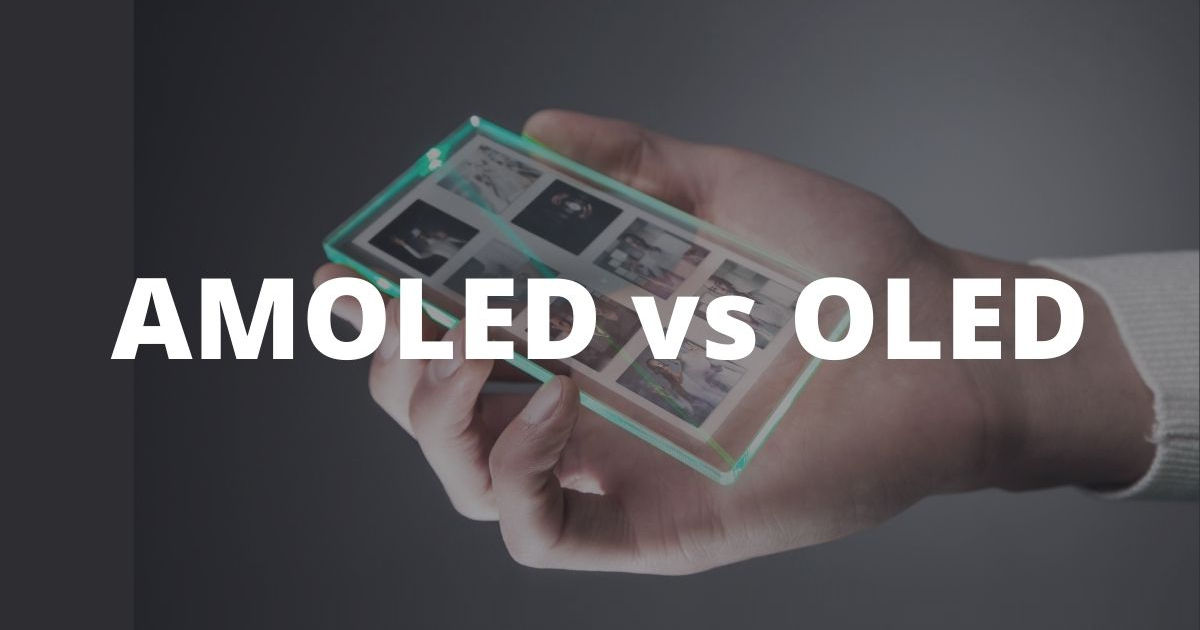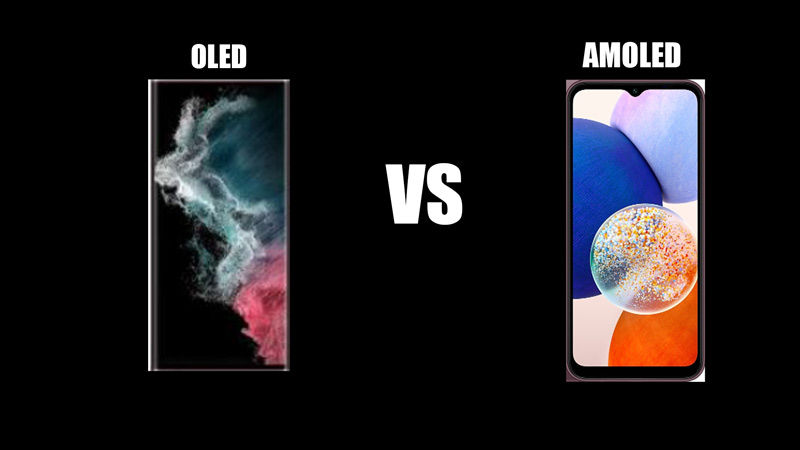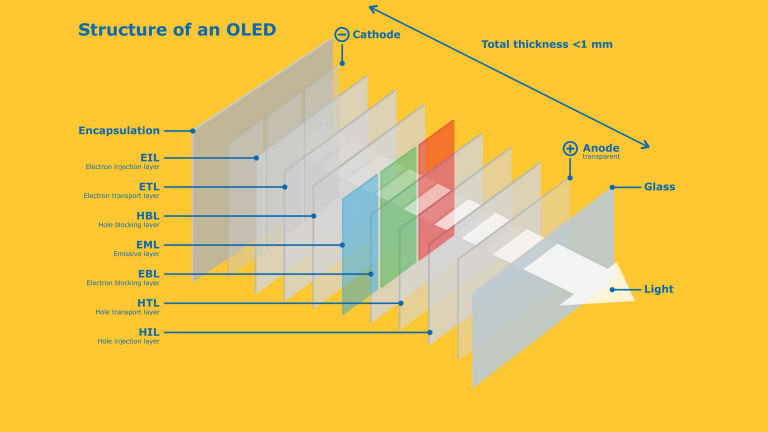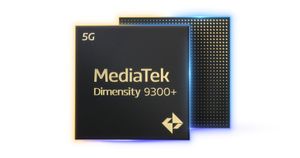
- OLED (Organic Light-Emitting Diode) and AMOLED (Active-Matrix Organic Light-Emitting Diode) are popular display technologies used in various electronic devices, especially smartphones.
- OLED and AMOLED are known for their vibrant and high-contrast visuals, offering an enhanced viewing experience.
- These technologies utilize organic compounds that emit light when an electric current passes through them, eliminating the need for a backlight and resulting in thinner and more flexible displays.
OLED (Organic Light-Emitting Diode) technology employs organic chemicals to produce light by applying an electric current. It consists of thin organic layers situated between transparent and non-transparent electrodes. Applying a voltage to these organic layers produces light energy by combining holes and electrons. OLED and AMOLED (Active-Matrix Organic Light-Emitting Diode) are the two primary display technologies used in portable devices like smartphones, smartwatches, gaming devices, and iPods. Both have gained popularity due to their numerous benefits.
This article explores the technology, working principles, price differences, effectiveness, and more, comprehensively comparing OLED and AMOLED displays. Interested readers can continue to gain a deeper understanding of these technologies.
OLED vs AMOLED Display

Both OLED (Organic Light-Emitting Diode) and AMOLED (Active-Matrix Organic Light-Emitting Diode) are display technologies that have become quite famous in recent times and are often seen being utilized in many different kinds of electronic devices, particularly in smartphones. There is no denying the fact that both OLED and AMOLED screens offer excellent image quality, yet they differ in certain aspects. It is noted that AMOLED displays outperform regular OLED displays when it comes to image quality, power economic performance, and longevity. They are, however, far more costly to manufacture. In the end, the decision between OLED and AMOLED displays is often seen to be affected by various different features such as budgetary constraints, desired image quality, and device requirements.
OLED vs AMOLED Technology

There is a contrasting difference between the two technologies that are often seen being used in smartphones and other technology devices. Below we have given a brief description of each of the two technologies.
- OLED Technology: As per the available data, it is known that Organic chemical compounds are used in OLED screens that are capable of producing light when an electric current is passed through them. Each of the pixels in a display made of OLED is self-emissive, indicating it independently generates its own light. The technology behind OLED displays offers excellent colour development, wide viewing angles, and swift response times. On the contrary, traditional OLED displays lack a specialized transistor for every pixel, leading to less accurate control over brightness and electricity consumption. OLED displays commonly utilize a Pentile matrix pixel arrangement, where red, green, and blue sub-pixels are organized in a diamond shape. It ought to be pointed out that OLED technology is not as efficient and durable as AMOLED technology.
- AMOLED Technology: An active-matrix layout can be found in AMOLED displays, which happens to be a type of OLED display. This implies that each AMOLED pixel contains a distinct thin-film transistor (TFT) for managing its brightness. The active-matrix design permits greater precision control over each of the pixels, and this results in more effective image quality, greater brightness ratios, and reduced electrical usage. AMOLED displays also feature more rapid refresh rates, making them ideal for watching videos and games. On the contrary, AMOLED displays frequently use a PenTile matrix with an additional white sub-pixel. This mentioned arrangement enhances the brightness and colour precision of AMOLED panels. It ought to be pointed out that AMOLED technology is more efficient and durable than OLED technology.
Working – AMOLED vs OLED
AMOLED (Active-Matrix Organic Light-Emitting Diode) and OLED (Organic Light-Emitting Diode) are distinct display technologies that utilize emissive organic chemicals to emit light.

- OLED: When a current of electricity passes through an OLED display, molecules of organic matter produce light. Each of the pixels in a display made from OLED works as a separate light source. Whenever a current of electricity flows through the organic chemicals wedged between the two conductive layers, they generate light. Adjusting the electric current regulates both the colour and brightness of each pixel.

- AMOLED: AMOLED displays, another kind of OLED display, utilize an active-matrix design. Each of the pixels in the AMOLED display has a connection to a thin-film transistor (TFT) that modulates the rate of flow of electric current. The Thin-Film Transistor (TFT) functions as a switching device, regulating the flow of current by either allowing or preventing it. This active-matrix design provides good regulation of each pixel’s illumination while simultaneously guaranteeing more rapid reaction times.
OLED vs AMOLED: Price
While considering the prices of OLED and AMOLED displays, keep in mind that AMOLED is nothing but an improved version of OLED. As a result, under a number of circumstances, the expense variance between both forms of technology may not be major or even visible. The retail value of OLED and AMOLED devices are determined by multiple variables, such as the size of the display, resolution, quantity of manufacturing, and demand from the market. One advantage of AMOLED displays over OLED displays is their superior flexibility. However, this enhanced flexibility comes at a higher cost, making AMOLED screens considerably more expensive than OLED screens.
OLED vs AMOLED Advantages and Disadvantages
OLED (Organic Light-Emitting Diode) and AMOLED (Active-Matrix Organic Light-Emitting Diode) are commonly employed in smartphones and other display technologies, each offering distinct advantages and disadvantages.
The noted advantages and disadvantages of OLED and AMOLED displays are given below:
- OLED: The primary benefits of well-known OLED technologies include their capacity to provide high contrast ratios, great image clarity, exceptional wide viewing angles, a fast response time, flexible displays, and the ability to consume less power.
The negative aspects of the technology are its short lifespan, high cost, low outside visibility, and susceptibility to burn-in.
- AMOLED: AMOLED technology retains some of the benefits of OLED technology, which include deep blacks, wide viewing angles, rapid reaction time, and energy efficiency. Additionally, it offers higher refresh rates, enhanced image clarity, and lower power consumption. Concerning the drawbacks, it has been shown that even AMOLED technology is prone to burn-in, experiences degeneration over time, and is costly.
AMOLED vs OLED: Which One Is Better?
When deciding between AMOLED and OLED, multiple factors and personal preferences need to be addressed. Both methods of display have benefits as well as drawbacks. When contrasted with AMOLED panels, OLED displays have considerably deeper blacks. Sunlight that is direct makes it impossible to see the screen on an AMOLED display. However, the AMOLED display’s image quality is significantly better than that of OLEDs due to the addition of a layer of TFTs and backplane technologies. Over time, OLED displays are vulnerable to pixel deterioration, which might lead to screen burn-in or image retention issues. AMOLED screens are similarly susceptible to burn-in. However, manufacturers have taken steps to reduce this issue.
Top 5 AMOLED Screen Phones in India 2023
The top 5 AMOLED screen phones in India 2023 are:
- Samsung Galaxy A54 5G
- Samsung Galaxy A34 5G
- Realme 11
- Realme 10
- Samsung Galaxy S20 FE 5G
FAQs
Which display technology offers better contrast and black levels?
It’s important to note that developments in AMOLED technology have resulted in significantly higher contrast and black levels than typical OLED panels. AMOLED displays frequently feature more vibrant colours and deeper blacks, resulting in a visually stunning viewing experience.
Are OLED and AMOLED displays equally vibrant in terms of colour reproduction?
Both OLED and AMOLED screens have been recognized for their vivid and precise colour reproduction. Both techniques utilize organic materials that release light independently for every pixel, allowing for precise colour control of the output. As a result, OLED and AMOLED screens are capable of producing colours that are rich and brilliant, with outstanding saturation. Both display technologies’ colour representation is typically considered to be excellent, providing a visually appealing and engaging viewing experience.
Which display type is more power-efficient, OLED or AMOLED?
AMOLED displays surpass traditional OLED screens when it comes to power efficiency. This is because AMOLED displays utilize an active matrix design that ensures each pixel is independently controlled, allowing for more effective power utilization.
Why are AMOLED displays not used on electronics such as TV and other big-screen devices?
AMOLED displays are commonly found in smaller electronic devices like mobile phones, tablets, and smartwatches. The higher cost of manufacturing larger AMOLED panels makes it less economical for bigger devices. Additionally, the production of larger AMOLED displays poses practical challenges and requires advanced manufacturing processes. These displays are susceptible to burn-in, and the manufacturing capacity for large-sized AMOLED panels is limited. As a result, LCD technology remains the preferred and popular choice for larger screen devices, such as TVs, due to its affordability, flexibility, and proven durability.
Do OLED and AMOLED displays have the same lifespan?
In general, the life expectancy of OLED and AMOLED displays is similar. Although OLED and AMOLED displays deteriorate with time, their expected lifespan could be more effective with good usage and upkeep.
In conclusion, we have comprehensively understood the two display technologies commonly used today. As both OLED and AMOLED come with their own set of advantages and disadvantages, the choice ultimately depends on the user’s preferences. For individuals interested in purchasing devices featuring either of these technologies, it is advisable to understand better their underlying principles and how well they cater to specific user needs.











